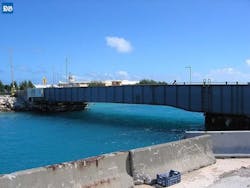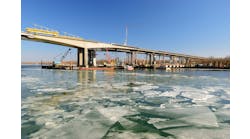The Longbird Bridge in Bermuda, a swinging asymmetrical steel span, was built across Castle Harbor by the US Navy in 1953 to facilitate movements to St. David’s Island near the Kindley Naval Air Station (now the Bermuda L. F. Wade International Airport). Due to the high chloride environment, hot-dip galvanized steel reinforcement was used in the concrete approach and bridge deck.
Bermuda, a British territory about 650 miles east of Cape Hatteras, North Carolina in the North Atlantic Ocean, has a tropical marine environment. No point in the archipelago of seven main islands and numerous islets is more than one kilometer from the sea, so salt spray and salt-laden air create a harsh, corrosive environment.
In addition to the environment, concrete used in the construction of bridges, seawalls, and buildings in Bermuda is often created with coral aggregates and mixed with seawater because fresh water is a rare resource. This introduces a high initial chloride concentration, amplifying the need to protect the steel reinforcement from corrosion. To combat corrosion, the US Navy chose hot-dip galvanized (HDG) rebar for the Longbird Bridge.
Over the nearly seven decades the Longbird Bridge stood, several inspections and corings were conducted to evaluate the galvanized rebar. In 1995, when the bridge was 42 years old, the HDG rebar coating thickness was in excess of the requirement for newly galvanized rebar even though the chloride levels were 3-9 lbs/yd3, well beyond the threshold limit of 1.1 lbs/yd3 for black rebar. The performance of the Longbird Bridge led Bermuda’s Ministry of Works and Engineering (MW&E) to exclusively specify hot-dip galvanized reinforcement for more than 50 years.
In 2008, the Longbird Bridge was closed due to damage from hurricanes and subsequently bypassed by temporary twin galvanized steel bridges. In 2020, nearly 70 years after its construction, Bermuda’s MW&E began demolition of the Longbird Bridge to make way for a new, larger replacement structure. Samples of the rebar were collected for analysis by Zinc Connections, LLC.
Based on the analysis and published report, the galvanized coating on the rebar samples was in exceptionally good condition, except for one small bare area. The zinc coating thickness measurements on each bar ranged from 3.8 to 11.6 mils. When averaging all samples together, the zinc coating thickness was equal to 6.0 mils which exceeds the minimum coating thickness for new rebar in ASTM A767 Class 1 (150µm or 5.9 mils).
For 67 years, the Longbird Bridge was subjected to heavy chloride concentrations from initial construction and its location just a few feet above the ocean in tidal and splash zones. Based on the findings, the hot-dip galvanized rebar still met ASTM A 767 Class 1 requirements, the modern-day standard for zinc coating thickness on new HDG rebar. Therefore, the hot-dip galvanized rebar would have easily provided the Longbird Bridge with a 100-year service life if it had not been damaged by hurricanes.
Editor's Note: Scranton Gillette Communications and the SGC Infrastructure Group are not liable for the accuracy, efficacy and validity of the claims made in this piece. The views expressed in this content do not reflect the position of the Roads & Bridges' Editorial Team.



